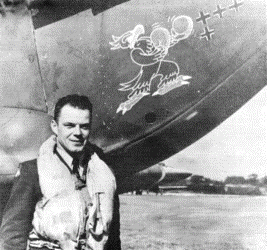Born in Minneapolis, Minnesota on November 16, 1916. William R. Dunn was the first Eagle Squadron pilot to shoot down a German aircraft, the first Eagle Squadron pilot to become an Ace, and the first official American Ace of WWII.. First flying Hurricanes with 71 Squadron, he shot down his first enemy machines in July 1941, before becoming an ace flying Spitfires with the same unit in August. It was while flying this machine that Dunn was forced to land at Hawkinge, in Kent, after sustaining injuries to his leg in combat over occupied France. Following brief service with 130 Squadron, Dunn became an instructor at various locations in Britain and the United States, before joining the USAAF on June 15, 1943. He became Group XO of the newly-organized 40t6th Fighter Group in October, 1943, and moved back to Britain with the unit in the Spring of 1944 as part of the tactical 9th Air Force. The unit moved to France following the invasion. After scoring a sixth victory that summer and sharing a seventh, Dunn scored his final victory in the war by shooting down a Bf-110 with a salvo of 5-inch rockets in October 1944. By the end of the war his score was 8.5 kills, 3 probables, 12 destroyed on the ground, over the course of 234 missions. Sent to China in 1945 to advise the Nationalist Air Force, Dunn flew with the Nationalists until the end of the Civil War in 1949. In the 1950s, he helped train the Iranian Imperial Air Force and the Brazilian Air Force. Dunn?s final combat duty was in Vietnam in 1967, with Headquarters, 7th Air Force, where he flew 62 missions over the Ho Chi Minh Trail evaluating infra red location equipment. After 38 years? service and 378 combat missions, LCOL William Dunn retired from the USAF in 1973.

PRIVATE CITIZENS SUPPORTING AMERICA'S HERITAGE
American
War Memorials Overseas, Inc.
War Memorials Overseas, Inc.
Dunn William Robert
Name:
William Robert Dunn
Rank:
Lieutenant Colonel
Serial Number:
Unit:
Headquarters, 7th Air Force
Date of Death:
0000-00-00
State:
Minnesota
Cemetery:
Plot:
Row:
Grave:
Decoration:
Comments:
